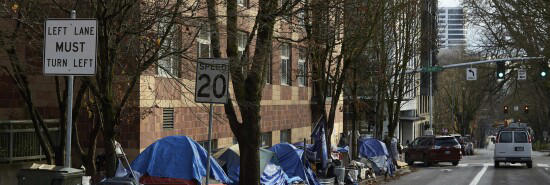By Breccan F. Thies -Washington Examiner
Portland, Oregon, lost $1 billion between 2020 and 2021 as residents fled rampant homelessness and crime, taking their tax dollars with them.
Those who moved were also relatively wealthy, with the former residents holding incomes 14% higher than persons who had moved out of the area the year before. Over the course of the year, the average income of county residents who stayed declined slightly.
That is a large shift for the Portland area historically, which had experienced 15 consecutive years of growth only to become one of America’s “fastest-shrinking” cities, according to Fox 12 News, which also reported that from July 2021 to July 2022, the area lost another 8,308 residents.
From the summer of 2020 to the summer of 2022, Portland lost nearly 3% of its population.
While many analysts, including Oregon Live, blame the coronavirus pandemic for the population decline, Portland trial attorney Kristen Olson told the Washington Examiner that explanation is an excuse not to talk about the homelessness, crime, and overdose deaths in the city.
“Most big cities saw a return of their residents after 2020. Portland did not,” Olson said. “What differentiates Portland from other big cities in the U.S. is that we have an enormous homelessness and fentanyl addiction epidemic and extremely high taxes for these same issues that paradoxically only seem to worsen the very problems they’re supposed to solve.”
The decline in population also tracks with Census Bureau data, showing Multnomah County having the largest population decline of any Oregon county.
As personal income taxes are the Beaver State’s largest source of funding, making up 86% of the state’s general fund, EcoNorthwest economist Mike Wilkerson told Oregon Live that the high levels of migration could stymie the liberal state’s ability to pay for social programs. Residents making salaries of $125,000 or more paid 24% of all income tax revenue.
That lack of funding is highlighted by the social and economic havoc created by Measure 110, which legalized all hard drugs in the state, producing massive spikes in homelessness and crime.
Despite the loss in revenue, the county’s budget continues to grow in order to pay for drug-related social programs.
“It won’t be a surprise if more people continue to leave, but the county chair should be very worried about who will be left to fund all of her high-tax, low-value programs,” Olson said, pointing to the city’s distribution of a “boofing pamphlet” — or, the act of injecting drugs through the anus — as part of drug abuse “harm reduction” expenditures that also include crack pipes.
Wheeler’s office did not respond to a request for comment from the Washington Examiner.

